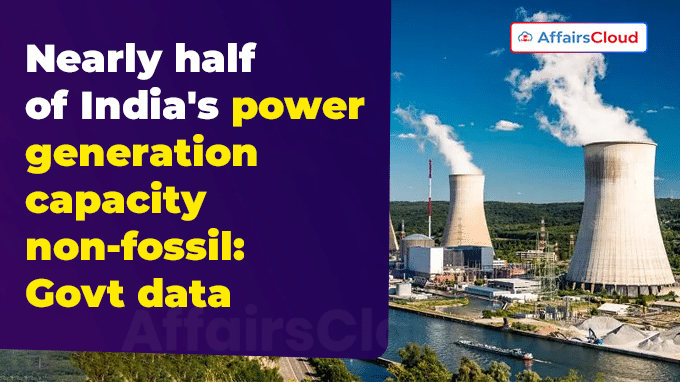 In June 2025, Government of India (GoI) released the latest data on India’s power generation capacity. As per the data, India’s total installed power capacity has increased from 305 Giga Watts (GW) in 2015-16 to 476 GW (as of June 2025).
In June 2025, Government of India (GoI) released the latest data on India’s power generation capacity. As per the data, India’s total installed power capacity has increased from 305 Giga Watts (GW) in 2015-16 to 476 GW (as of June 2025).
- The data showed that nearly half i.e. 49% (235.7 GW) of India’s total power generation capacity comes from non-fossil fuel sources, including 226.9 GW of Renewable Energy (RE) and 8.8 GW of nuclear power.
- However, Thermal Power alone accounts for 50.52% (240 GW) of India’s total installed power capacity.
- While, Coal alone contributes more than 91% of all thermal-based energy, which signifies its vital role in meeting the country’s rising power demand.
Key Findings:
i.Increase in Electricity Generation: The electricity generation has increased from 1,168 Billion Units (BU) in 2015-16 to an estimated 1,824 BU in 2024-25.
ii.Expansion in RE Capacity: The installed RE capacity in India has increased by nearly 3 times i.e. from 76.37 GW (in March 2014) to 226.79 GW (in June 2025).
- RE generation has increased from 190.96 BU (in 2014-15) to 370.65 BU (in 2024-25), with its overall share in power generation increasing from 17.20% to approximately 22.20%.
iii.Reduction in Power Shortages: As per the data, power shortages decreased from 4.2% (in 2013-14) to 0.1% (in 2024-25).
iv.Increase in Power Consumption: The data revealed that per capita electricity consumption increased by 45.8% to 1,395 kilowatt-hour (kWh) (in 2023-24) compared to 957 kWh (in 2013-14).
v.Electrification of Households: India achieved 100% village electrification by April 2018 and since then, GoI has connected over 2.8 crore households to the grid.
Note: According to International Renewable Energy Agency (IRENA) RE Statistics 2025, India ranks 4th globally in RE Installed Capacity, 4th in Wind Power, and 3rd in Solar Power Capacity.
Key Accomplishments of Various RE Sources:
i.Solar Power: As per the Ministry of Power (MoP)’s official data, India’s total solar capacity has increased over 39 times, from 2.82 GW (in 2014) to 110.9 GW (in 2025), of which 23.83 GW was added alone in Financial Year 2024-25(FY25).
ii.Wind Energy (2014-15): As per the data, installed capacity increased from around 21 GW (in 2014) to 51.3 GW (as of June 2025), which marks an increase of more than 50% in a decade. Out of 51.3GW, 4.15 GW added in FY25 alone.
- Electricity generation by wind energy surged to 78.21 BU between April 2024 and February 2025, contributing 4.69% to total electricity generation.
- According to Chennai (Tamil Nadu, TN) based National Institute of Wind Energy (NIWE), India’s estimated wind potential is 1164 GW at 150 meters (m) above ground level.
iii.Hydropower expansion: Hydro power capacity increased from 35.8 GW (FY14) to 48 GW (FY25). India aims to increase its hydro power capacity to 55 GW by 2030, supported by Inter State Transmission System (ISTS) charges waivers and equity assistance for North-East (NE) projects.
iv.Bio Power: Between 2014 and 2025, India’s biopower generation capacity increased from 8.1 GW to 11.6 GW.
- Compressed Biogas (CBG) generation capacity expanded from a single project with 8 Tonnes per Day (TPD) in 2014 to 150 projects, with combined capacity of 1,211 TPD (as of March 2025).
Key Flagship Schemes & Programmes for Solar Energy:
i.Prime Minister Surya Ghar: Muft Bijli Yojana (PM-SGMBY): It is the world’s largest domestic rooftop scheme, launched in February 2024, aims to provide free electricity of 300 units per month to 1 crore households in India by March 2027.
- With budgetary allocation of Rs 75,021 crore, the scheme targets an addition of 30 GW in solar capacity through solar rooftop in residential sector, potentially generating 1 lakh crore units over 25 years and reducing 720 MMT of Carbon Dioxide (CO2) emissions.
ii.Pradhan Mantri Kisan Urja Suraksha Evam Uttan Mahabhiyan (PM-KUSUM): The scheme was launched in March 2019, aims to enhance farmers’ income by providing energy and water security and de-dieselisation of the farm sector.
- Under this scheme, GoI provides financial assistance to the farmers for installation of standalone solar pumps and solarization of existing grid-connected agriculture pumps, and installing solar power plants on their barren agricultural land.
- Key Target: To add 34.8 GW of solar capacity nationwide, with a total financial outlay of Rs 34,422 crore.
- The scheme comprises 3 main components (A, B, and C) and now all these components are covered under the Agriculture Infrastructure Fund (AIF) for easy financing.
iii.Solar Parks: This scheme provides large-scale grid-connected solar power projects with required infrastructure such as: land, power evacuation facilities, road connectivity, water facility, among others with all statutory clearances.
- Key Target: To generate 40 GW by March 2026.
- So far, GoI has approved total 55 parks, with combined capacity of 39,958 MW in 13 states of the country.
- Out of these 55 solar parks, 24 parks have been commissioned, generating 12,804 MW of power.
iv.PLI Scheme for High Efficiency Solar PV Modules: The scheme with budgetary outlay of Rs 24,000 crore, aims to boost domestic manufacturing by reducing dependence on import.
- Under this scheme, GoI has issued Letters of Award for setting up of 48,337 MW of fully or partially integrated solar PV module manufacturing capacities.
v.Pradhan Mantri Janjati Adivasi Nyaya Maha Abhiyan (PM-JANMAN) Scheme: It was launched in November 2023, aims to address the development requirements of Particularly Vulnerable Tribal Groups (PVTGs) through 11 critical interventions across 9 ministries.
- Under this scheme, a new solar power scheme was launched ‘Dharti Aaba Janjatiya Gram Utkarsh Abhiyan (DA JGUA)’, with budgetary allocation of Rs 515 crore, aimed at electrifying 1 lakh un-electrified households in tribal and PVTG habitations across 18 states of the country.
Key Accomplishments of Nuclear Energy:
i.Increase in Nuclear Energy Generation: Nuclear electricity generation has increased from 35,592 Million Units (MUs) (2014-15) to 56,681 (2024-25), marking an increase of 60% on yearly basis.
ii.Surge in Installed Capacity of Nuclear Energy: Installed nuclear capacity has increased by 71%, from around 4,780 MW (in 2014) to 8,780 MW (in 2025), across 25 nuclear reactors operated by Nuclear Power Corporation of India Limited (NPCIL).
iii.Increase in Plant Load Factor: 87% plant load factor achieved in Financial Year 2024-25 (FY25).
- Capacity factor and availability factor above 80% for all operating reactors, over the last 5 years.
Key Accomplishments of Coal Sector:
i.Key Contributors to power generation: As of June 2025, Coal continues to be the dominant contributor with a capacity of 219 GW. While, Gas-based power contributes 20 GW and diesel-based power adds another 589 MW.
ii.Increase in Revenue Sharing with Coal Bearing states: As per the Ministry of Coal (MoC)’s data, since 2014-15, coal Public Sector Undertakings (PSUs) distributed a total revenue of Rs 1.8 lakh crores to coal-bearing states.
iii.Increase in Production & Supply Growth: Coal production increased from 609.18 Million Tonnes (MT) in 2014-15 to 1,047.68 MT in 2024-25, marking an increase of 72%.
- Similarly, coal supply surged from 603.77 Mt to 1,025.25 MT over the last 11 years.
iv.Import reduction: India’s import dependency has decreased from 26% (2014-15) to about 21% (in 2023-24). It has further decreased to 19.60% in FY25 till January 2025.
Key Accomplishments of Oil and Gas Sector:
The oil and Gas sector is one of India’s 8 core industries and plays a crucial role in accelerating the country’s economy. As of 2023, India is the world’s 3rd-largest oil consumer which signifies its vital role for country’s energy security and future growth.
i.Increase in LPG connections: As per GoI’s data, Liquefied Petroleum Gas (LPG) connections increased from 14.51 crore (2014) to 32.97 crore (2025).
- As of March 2025, total 10.33 crore LPG connections distributed under Pradhan Mantri Ujjwala Yojana (PMUY) across India.
- Under PMUY, 8.34 crore beneficiaries availed minimum one refill during April 2022-March 2024.
ii.Expansion of Piped Natural Gas (PNG) and Compressed Natural Gas (CNG): PNG connections increased by nearly 6-times, from 0.254 crore (2014) to 1.47 crore (2025).
iii.Natural Gas Pipeline & LNG Infrastructure: Operational natural gas pipelines increased from 15,340 kilometer (km) to 25,124 km (2025).
- Number of Liquefied Natural Gas (LNG) terminals increased from 4 to 8, and their capacity increased from 22 Million Metric Tons per Annum (MMTPA) to 52.7 MMTPA.
iv.Biofuel & Ethanol Blending Process: The National Policy on Biofuels which was launched in 2018 and was later amended in 2022, aimed to achieve 20% ethanol blending by 2025-26.
- Ethanol blending increased from 1.53% (2014) to 18.5% (2025).
- Ethanol procurement increased significantly from 38 crore litres (in 2014) to 440.74 crore litres (in 2025).
- Bio-diesel procurement increased exponentially from 1.19 litres (2015-16) to 43.99 crore litres (2024).
About Ministry of Power (MoP):
Union Minister- Manohar Lal Khattar (Constituency- Karnal, Haryana)
Minister of State(MoS) – Sripad Naik(Constituency- North Goa, Goa)




